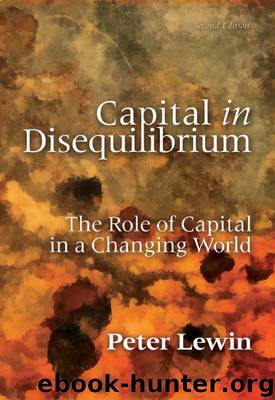Capital in Disequilibrium by Peter Lewin

Author:Peter Lewin [Peter Lewin]
Language: eng
Format: epub
ISBN: 978-1-61016-239-5
Publisher: Ludwig von Mises Institute
Published: 2011-11-06T16:00:00+00:00
Lachmann’s Conceptual Framework
The Structure of Capital
Perhaps the most important development of Hayek’s original project is to be found in Lachmann’s capital theory. In 1956, Lachmann, who had been a student and colleague of Hayek’s at the London School of Economics, published Capital and its Structure (Lachmann 1978).6 This work was really the culmination of his earlier work on capital, the most complete of which was his 1947 article (see Lachmann 1938,1939, 1941, 1944, 1947, 1948; see also Lewin 1997a).
According to Lachmann:
The generic concept of capital without which economists cannot do their work has no measurable counterpart among material objects; it reflects the entrepreneurial appraisal of such objects. Beer barrels and blast furnaces, harbor installations and hotel room furniture are capital not by virtue of their physical properties but by virtue of their economic functions. Something is capital because the market, the consensus of entrepreneurial minds, regards it as capable of yielding an income. . . . [But] the stock of capital used by society does not present a picture of chaos. Its arrangement is not arbitrary. There is some order to it.
(Lachmann 1978:xv)
The value of the capital stock, being dependent on individual expectations and evaluations (time preferences included), is not an objectively observable phenomenon or necessarily even a meaningful concept. Only in equilibrium, where all individuals’ expectations were consistent one with the other, would such a value have any meaning. Lachmann chooses to develop his analysis in a disequilibrium framework. In other words, Lachmann considered the notion of a capital stock (which made sense in an equilibrium context) to be untenable and unhelpful in a disequilibrium world. He thus offers a theory of the capital structure rather than the capital stock.
Lachmann thus emphasizes the heterogeneity of the capital stock. The fact that capital goods are physically very dissimilar is significant precisely because of the existence of disequilibrium. Physical heterogeneity could be reduced to value homogeneity if the values of the various capital goods could be simply added together. Where disequilibrium means that individuals have different and frequently inconsistent expectations, one cannot simply add together individual valuations. The physical heterogeneity is not the essence of the matter. Different physical goods that perform the same economic function could be counted as the same good. It is the difference in economic function that matters. For the most part different capital goods look different because they are designed to perform different functions. But the same capital good could perform different functions under different circumstances. Heterogeneity in use is the key.
Although the capital stock is heterogeneous, it is not an amorphous heap. The various components of the capital stock stand in sensible relationship to one another because they perform specific functions together. That is to say, they are used in various capital combinations. If we understand the logic of capital combinations, we give meaning to the capital stock and, in this way, we are able to design appropriate economic policies or, even more importantly, avoid inappropriate ones (for example Lachmann 1978:123).
Download
This site does not store any files on its server. We only index and link to content provided by other sites. Please contact the content providers to delete copyright contents if any and email us, we'll remove relevant links or contents immediately.
International Integration of the Brazilian Economy by Elias C. Grivoyannis(91957)
The Radium Girls by Kate Moore(11930)
Turbulence by E. J. Noyes(7942)
Nudge - Improving Decisions about Health, Wealth, and Happiness by Thaler Sunstein(7622)
The Black Swan by Nassim Nicholas Taleb(7016)
Rich Dad Poor Dad by Robert T. Kiyosaki(6414)
Pioneering Portfolio Management by David F. Swensen(6230)
Man-made Catastrophes and Risk Information Concealment by Dmitry Chernov & Didier Sornette(5926)
Zero to One by Peter Thiel(5692)
Secrecy World by Jake Bernstein(4652)
Millionaire: The Philanderer, Gambler, and Duelist Who Invented Modern Finance by Janet Gleeson(4386)
The Age of Surveillance Capitalism by Shoshana Zuboff(4216)
Skin in the Game by Nassim Nicholas Taleb(4165)
Bullshit Jobs by David Graeber(4101)
The Money Culture by Michael Lewis(4083)
Skin in the Game: Hidden Asymmetries in Daily Life by Nassim Nicholas Taleb(3935)
The Dhandho Investor by Mohnish Pabrai(3706)
The Wisdom of Finance by Mihir Desai(3659)
Blockchain Basics by Daniel Drescher(3511)
